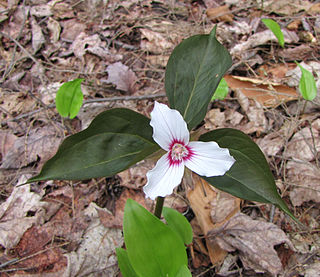
Actaea, commonly called baneberry, bugbane and cohosh, is a genus of flowering plants of the family Ranunculaceae, native to subtropical, temperate and subarctic regions of Europe, Asia and North America.

Zoysia is a genus of creeping grasses widespread across much of Asia and Australia, as well as various islands in the Pacific. These species, commonly called zoysia or zoysiagrass, are found in coastal areas or grasslands. It is a popular choice for fairways and teeing areas at golf courses. The genus is named after the Slovenian botanist Karl von Zois (1756–1799).

Vaccinium erythrocarpum – also commonly known as mountain blueberry, southern mountain cranberry, bearberry, arando, and dingleberry – is a species of cranberry.

Eriophorum is a genus of flowering plants in the family Cyperaceae, the sedge family. They are found throughout the arctic, subarctic, and temperate portions of the Northern Hemisphere in acid bog habitats, being particularly abundant in Arctic tundra regions.

Rubus strigosus, the American red raspberry or American raspberry, is a species of Rubus native to much of North America. It has often been treated as a variety or subspecies of the closely related Eurasian Rubus idaeus, but currently is more commonly treated as a distinct species. Many of the commercial raspberry cultivars grown for their fruit derive from hybrids between R. strigosus and R. idaeus; see Raspberry for more details.

Trillium undulatum, the painted trillium, is a species of flowering plant in the family Melanthiaceae. It is also known as painted lady, smiling wake robin, or trille ondulé in French. The plant is found from Ontario in the north to northern Georgia in the south and from Michigan in the west to Nova Scotia in the east. It demands strongly acidic, humus-rich soils and tends to be found in the shade of acid-loving trees such as eastern white pine, red maple, red spruce and balsam fir. Although the soils that support it have low base saturation, this species was found to have relatively high levels of calcium, magnesium, and especially potassium in its foliage.

Cenchrus longispinus is a species of grass, also known as spiny burr grass or gentle Annie. Its fruits are clumped into "burrs" with sharp, barbed spines that can penetrate the hides and mouth of grazing animals. They can also become lodged in human clothing, causing some discomfort.

Beckmannia eruciformis, the European slough-grass or slough grass, is an annual or short lived perennial in the grass family, Poaceae, found in shallow marshes or sloughs, and used for animal fodder and forage.

Benjamin Lincoln Robinson was an American botanist.

Pleuropogon oregonus is a species of grass known by the common name Oregon semaphoregrass.
Malaxis bayardii, or Bayard's adder's-mouth orchid, is a species of orchid native to northeastern North America. It is found from Massachusetts to North Carolina, with isolated populations in Ohio and Nova Scotia. There are historical reports of the plant formerly growing in Vermont and New Jersey, but it seems to have been extirpated in those two states It grows in dry, open woods and pine barrens at elevations of less than 600 m.

Lophiola is a genus of monocotyledonous flowering plants native to eastern North America. It has variously been placed in the Liliaceae, the Haemodoraceae, the Tecophilaeaceae or the Nartheciaceae.
Bidens eatonii is a North American species of flowering plant in the daisy family. It is native to eastern Canada and the northeastern United States.
Bidens heterodoxa, the Connecticut beggarticks, is a North American species of flowering plant in the daisy family. It is native to eastern Canada and the northeastern United States (Connecticut).
Boltonia caroliniana, common name Carolina doll's-daisy, is a North American species of plants in the sunflower family. It is found only in the southeastern United States, primarily in the states of North Carolina, South Carolina, and Virginia with a few isolated populations in western Georgia.
Rubus aculifer, the thorny dewberry, is a rare North American species of flowering plant in the rose family.
Rubus adjacens, the peaty dewberry, is a rare North American species of flowering plant in the rose family. It is native to eastern Canada and the northeastern and east-central United States (Maine, New Hampshire, Vermont, Massachusetts, New York, Pennsylvania, Maryland.
Rubus defectionis, the Eclipse blackberry, is a rare North American species of flowering plant in the rose family. It grows in only a few locations in the east-central United States.
Glyceria acutiflora, the creeping mannagrass, is a perennial grass found in the north-eastern United States and in north-eastern Asia. Its specific epithet acutiflora means "acute-flowered". It has a diploid number of 40.
Lysimachia × commixta is a hybrid of flowering plants in the primrose family Primulaceae. It is native to eastern North America, from eastern Canada across the Great Lakes region west to Minnesota. The hybrid specific epithet commixta means "mixed together, mixed up", which presumably refers to the genetic mixing of two species. Indeed, the hybrid is sometimes referred to as the mixed loosestrife or the commingling loosestrife.











